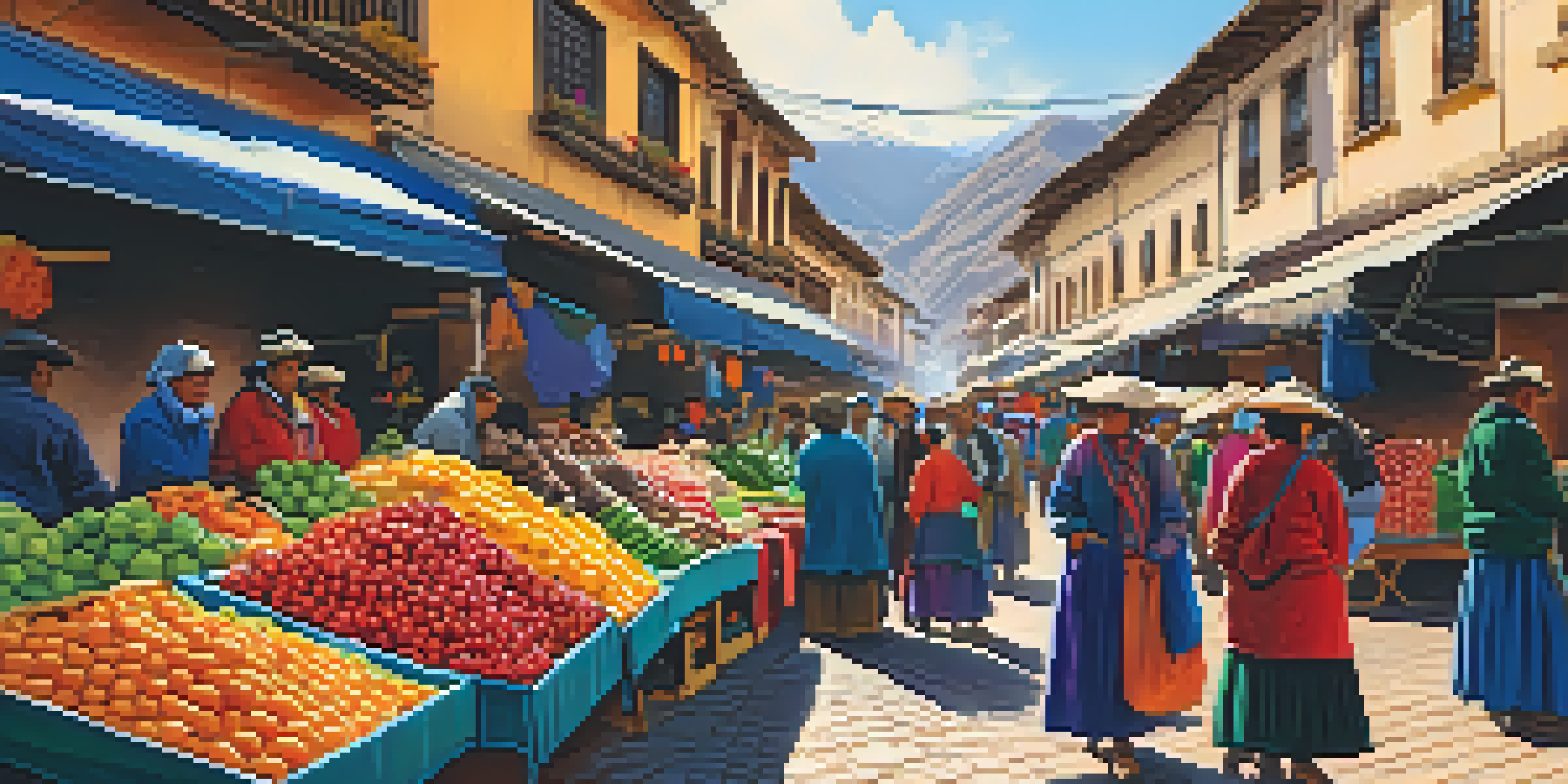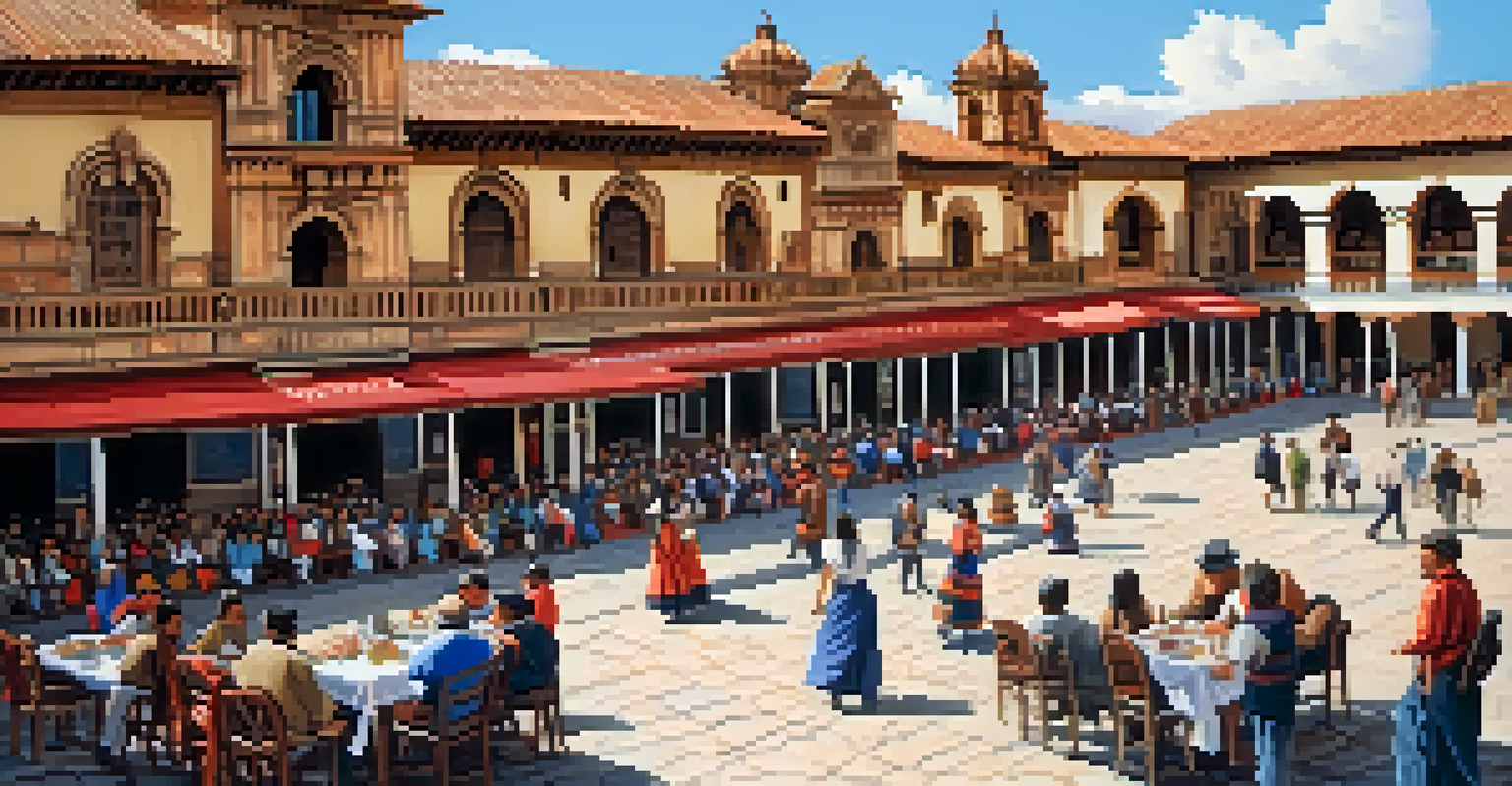Tourism in Peru: The Influence of Colonialism and Trade

Peru's Rich Cultural Tapestry: A Colonial Legacy
Peru's tourism is deeply intertwined with its colonial history, which began in the 16th century when Spanish conquistadors arrived. This period introduced European architecture, traditions, and religions that have blended with indigenous cultures. For instance, the stunning baroque churches in cities like Cusco showcase a fusion of Spanish and Incan influences, attracting countless visitors each year.
Cultural heritage is the foundation of our identity, and the key to understanding our past.
Travelers flock to sites like Machu Picchu, not just for their breathtaking views, but to experience the complex history that colonialism has left behind. These ancient ruins, once a thriving Incan citadel, now symbolize the resilience of indigenous culture amidst colonial oppression. The narrative of conquest and survival makes Peru’s historical sites profoundly engaging for tourists.
Moreover, the legacy of colonialism is evident in Peru's diverse festivals, which often blend indigenous and Spanish traditions. Events like Inti Raymi, the Festival of the Sun, highlight this rich cultural exchange. Such festivals not only draw tourists looking for unique experiences but also serve to preserve and celebrate Peru's multifaceted heritage.
Trade Routes: Connecting Cultures and Economies
Trade has played a crucial role in shaping Peru's tourism landscape, with ancient trade routes facilitating cultural exchanges long before colonial times. The Inca Empire established extensive road systems that connected various regions, allowing for the movement of goods, ideas, and people. Today, these routes serve as pathways for adventurous tourists eager to explore Peru's diverse geography.

During the colonial era, the Spanish established new trade routes that further integrated Peru into the global economy. The export of precious metals, especially silver from Potosí, transformed cities like Lima into bustling trade hubs, fostering a vibrant mix of cultures. This historical backdrop enriches the experience for modern tourists who learn about the economic forces that shaped the nation.
Peru's Colonial Legacy Enhances Tourism
The rich blend of indigenous and Spanish cultures, showcased in architecture and historical sites, draws tourists eager to explore Peru's past.
Today, Peru continues to thrive on trade, particularly in agriculture and handicrafts, enhancing its appeal to tourists. From vibrant markets in Cusco to gourmet food tours in Lima, visitors can experience the dynamic interplay of tradition and modernity. These elements contribute to an engaging narrative that captures the essence of Peru's evolving identity.
Impact of Colonial Architecture on Tourism
The stunning colonial architecture found across Peru is a significant draw for tourists. Cities like Arequipa and Cusco are adorned with beautiful colonial buildings, showcasing intricate stonework and vibrant colors that tell stories of the past. These structures not only reflect the artistic influences of the time but also serve as reminders of the cultural blend that emerged from colonial rule.
Tourism is not just about seeing new places; it's about experiencing the world in a way that brings us closer to its diverse cultures.
Tourists often find themselves enchanted by the charm of colonial plazas, lined with cafes and shops, where they can soak in the local culture. The Plaza de Armas in Cusco, for example, is a lively hub where visitors can enjoy traditional performances while surrounded by historical landmarks. This ambiance creates a unique experience that enhances their understanding of Peru's colonial history.
Moreover, the preservation of these architectural marvels has become a priority for the Peruvian government, understanding their importance in attracting visitors. By investing in restoration projects, Peru not only safeguards its heritage but also boosts tourism, creating economic opportunities for local communities. This synergy between preservation and tourism ensures that the stories of the past continue to intrigue future generations.
Indigenous Culture: Resilience and Tourism
Despite the overwhelming influence of colonialism, indigenous cultures in Peru have shown remarkable resilience. Communities such as the Quechua and Aymara continue to thrive, preserving their languages, traditions, and crafts. Tourists seeking an authentic experience often visit these communities, gaining insights into their rich cultural practices and the impact of colonial history.
Cultural tourism initiatives have emerged, focusing on sustainable practices that benefit both visitors and indigenous populations. Programs that promote local crafts, traditional music, and community-led tours allow for a deeper understanding of indigenous lifestyles. This not only enriches the tourist experience but also empowers local communities economically.
Culinary Tourism Showcases Peru's Identity
Peruvian cuisine, a fusion of diverse influences, has become a key attraction for food enthusiasts, celebrating the country's cultural heritage.
As travelers engage with indigenous cultures, they contribute to a broader narrative that respects and honors these traditions. This interaction fosters a greater appreciation for the complexity of Peru's identity, merging past and present in a way that benefits everyone involved. It highlights the importance of mutual respect and understanding in the tourism industry.
Culinary Tourism: A Taste of Peru's History
Peruvian cuisine is a vital aspect of its cultural identity, reflecting the influences of colonialism and indigenous practices. The fusion of ingredients and cooking techniques from different cultures has led to a culinary renaissance that attracts food enthusiasts worldwide. Dishes like ceviche and lomo saltado showcase this blend, offering tourists a delicious way to connect with Peru's history.
Food markets and cooking classes have become popular among travelers eager to explore local flavors. Visiting vibrant markets, such as Mercado de San Pedro in Cusco, allows tourists to engage with local vendors and taste authentic Peruvian dishes. This hands-on experience deepens their appreciation for the culinary traditions that have evolved over centuries.
Moreover, the rise of gastronomic tourism has positioned Peru as a culinary destination on the global stage. Renowned chefs are showcasing Peruvian ingredients and techniques in award-winning restaurants, further enhancing its appeal. This focus on food not only promotes tourism but also strengthens cultural pride among Peruvians, celebrating the rich tapestry of influences that shape their cuisine.
Sustainable Tourism: Balancing Heritage and Growth
As tourism continues to grow in Peru, the challenge of sustainable practices has become increasingly important. The influx of visitors can strain local resources, but many initiatives are underway to balance tourism with heritage conservation. By prioritizing sustainability, Peru aims to protect its cultural and natural treasures while providing enriching experiences for tourists.
Community-based tourism is one approach that empowers local populations while promoting environmental stewardship. Initiatives that involve local communities in tourism development help ensure that benefits are shared equitably. This not only enhances the visitor experience but also fosters a sense of ownership among locals towards their cultural heritage.
Sustainable Practices for Future Tourism
Community-based and sustainable tourism initiatives are essential for preserving Peru's cultural and natural treasures while enhancing visitor experiences.
Sustainable tourism also encourages travelers to be more conscious of their impact on the environment and local cultures. By promoting responsible travel practices, Peru can preserve its unique identity for future generations. This commitment to sustainability ensures that tourism remains a positive force for both visitors and the communities they engage with.
The Future of Tourism in Peru: Embracing Change
As Peru navigates the complexities of a post-pandemic world, the future of tourism looks promising yet challenging. With an increasing focus on health and safety, the industry is adapting to meet the needs of travelers. Innovations in technology and marketing strategies are helping to attract visitors while ensuring their well-being.
Additionally, there is a growing emphasis on promoting lesser-known destinations, encouraging tourists to explore beyond traditional hotspots. This shift not only alleviates pressure on popular areas but also supports local economies in more remote regions. By diversifying tourism offerings, Peru can showcase its rich cultural heritage more broadly.

Ultimately, the future of tourism in Peru will hinge on its ability to balance growth with sustainability. By honoring its colonial past and embracing the vibrant cultures that exist today, Peru can create a tourism model that respects its history while looking forward. This harmonious approach will ensure that Peru remains a beloved destination for generations to come.